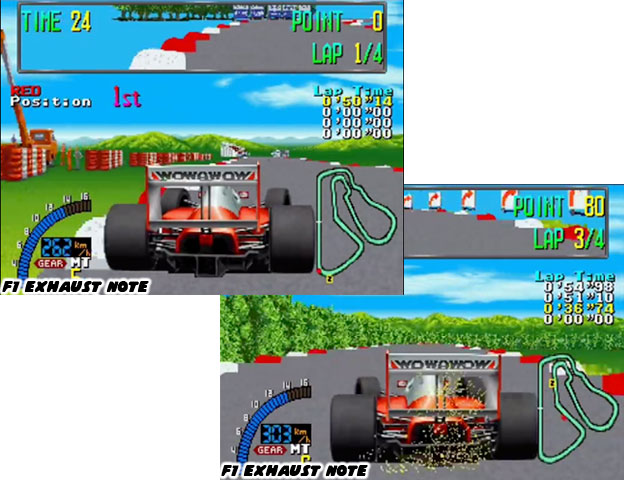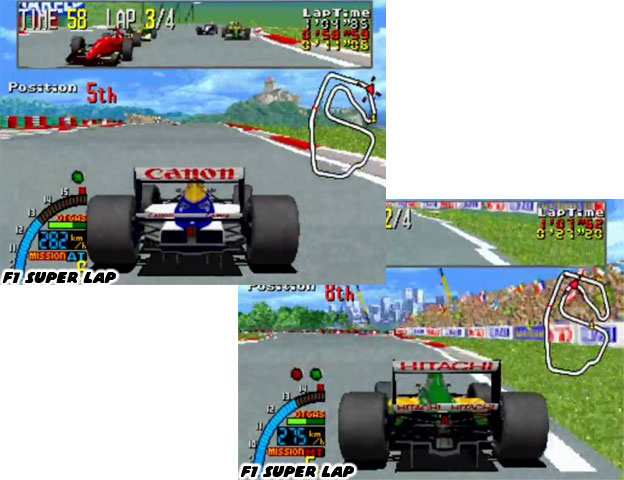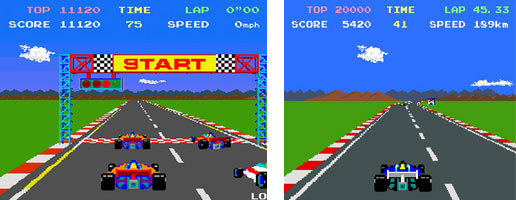In a previous blog I had highlighted the 1989 Super Monaco GP arcade cabinet. The game itself was considered a successor to the classic 1979 Sega game Monaco GP. It was revolutionary in terms of graphics, sound and control (it was the one that featured paddle shifters). Unlike the stall that Namco had between Pole Position and Final Lap. Super Monaco GP was a game that pushed the genre forward. It was something that fans, and especially newfound fans of Formula-1 could get behind. When the game was ported to the consoles Sega had signed up the super talented and charismatic driver Ayrton Senna to be the poster child. The console version did not have the amazing graphics of the arcade but it added plenty of real world tracks to keep the player going. Sega was dead serious about dethroning Namco as the makers of the best F1 racing titles. In format and presentation Final Lap and Pole Position were very similar. Granted Final Lap looked much more detailed it still had a very similar aesthetic. On the other hand the graphical leap from Monaco GP to Super Monaco GP was like night and day. Sega broke even more ground with the 1991 racer F1 Exhaust Note.

The game used pixel scaling to create roads that had a feature that the Namco games did not. The tracks in Exhaust Note, like Super Monaco GP featured changes in elevation which reflected the actual tracks that the game was set in. The game was also much easier to control than Final Lap while still providing a genuine challenge to veteran gamers. That title featured a car that was massive on the screen and among one of the highest detailed sprites ever created. The tiny cars and flat tracks in Final Lap were outdated by comparison.

A year lated Sega topped themselves again with
F1 Super Lap. The 1992 title was actually a licensed game and featured actual logos and livery from Formula-1 teams. Prior to that Sega, like most companies simply mimicked the colors and logos from companies. Those shortcuts were often good enough for most gamers and even racing fans. Apparently the publisher had done so well in arcade and console development that they could afford the pricey licensing costs. The game itself was stunning. They had improved on every element that made Super Monaco GP and Exhaust Note so successful. There was a bump in the graphics department, the winged cars and sprite based tracks had never looked better. The detail that I found most improved over the previous Sega titles was actually the rear view mirror. The studio had used it in previous games to help players block out cars from trying to pass them. The "fish eye" camera effect that the rear view mirror had in Super Lap was amazing. The sprite cars seemed to distort and deform in real time depending on their proximity and position to the player. It was a unique visual trick that I would not guess to fathom how much programming was required to accomplish.

Namco seemed to be outclassed at this point. The Sega F1 gems were released in quick succession following the debut of Final Lap 2 and 3. To clarify the Sega graphic powerhouses actually predated even Final Lap R. Namco did not seem to have an excuse as to why older games from a rival studio looked much better than their own. The house that Pole Position built had been shaken to the core. Yet Namco and Sega both knew that sprite based racing games were nearing the end of their life expectancy. In fact the reliance on pixel art was becoming slow and time consuming for all the major publishers. Time was money and the man hours spent fine tuning hand drawn art to work in a game engine would hurt the bottom line. Sooner or later sprite based games in every genre would be falling out of favor. The industry would have to look for new ways to develop and render visuals that were faster, more cost effective and more aesthetically pleasing. Three-dimensional polygons seemed to be the next step for computer-aided visuals. Both Sega and Namco would begin pushing their teams in that direction. Those studios knew that they had to create hits in the most popular genres using 3D technology. They could not rely on just racing games to do that but had to branch out into different experiences.

Sega and Namco were no strangers to other formats. Both studios had released titles in plenty of genres. Puzzle games, brawlers, sports, sci-fi, action, fantasy, shooters and RPG hits had given both companies a broad portfolio to draw inspiration from. Yet they also knew that they could not simply release a 3D version of an older game and expect a positive response. Early polygonal engines were very crude and blocky. They did not appear to have as nice visuals as many sprite based hits. Aesthetically that was the case but polygon games offered a realistic sense of depth, weight and physics that no sprite based title could ever hope to recreate. Sega and Namco had to refine the tastes of their long time followers. They had to build a case and convince the most die-hard fans that their favorite titles would have to evolve or the company would die. They had to change the culture that they helped build through the '80s and the only way to do that was by showing audiences how amazing the future was. It was not easy at first but little by little both companies won over audiences. The next blog will highlight were Sega and Namco began to pull away from the competition while still managing to trade blows with each other.
As always if you would like to sponsor me
please visit my Patreon page and consider donating each month, even as little as $1 would help make better blogs and even podcasts!








I've played a few of the SEGA F1 games but I don't even recall seeing a Final Lap game and giving it a go.
ReplyDelete